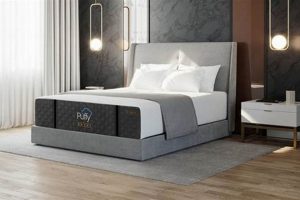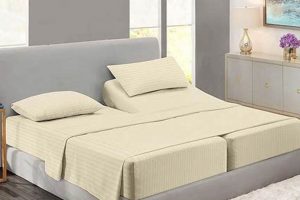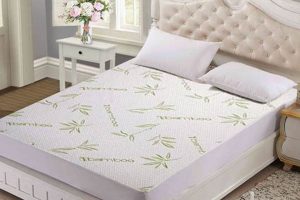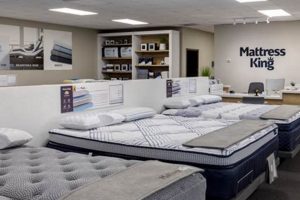A bed configuration consisting of two separate mattresses, each half the width of a traditional king-size mattress, resting side-by-side on an adjustable base or within a single bed frame. This arrangement effectively creates a king-size sleeping surface while allowing for independent adjustment and personalized comfort on each side. For example, one individual might prefer a firmer sleeping surface and a raised head position, while their partner desires a softer feel and a flat sleeping position, all accommodated within the same bed.
This configuration addresses the common problem of differing sleep preferences and physical needs within a shared bed. Its significance lies in its ability to enhance sleep quality and reduce partner disturbance. The individual mattress adjustability minimizes motion transfer, leading to fewer disruptions throughout the night. Historically, this setup emerged as a solution for couples seeking a compromise between personal comfort and shared sleeping space, evolving alongside the advancement of adjustable bed frame technology and mattress material innovations.
Having defined this particular type of bed, the following sections will delve into the specific advantages, ideal candidate profiles, and considerations when selecting the appropriate mattress type and adjustable base for optimal comfort and functionality. Further examination will also be made into the various mattress materials and features that can enhance the experience, along with a comparison to alternative bed configurations to aid in informed decision-making.
Guidance for Selecting a Split Mattress King
The following recommendations provide valuable insights to aid in selecting this type of mattress, ensuring optimal comfort, support, and long-term satisfaction. Careful consideration of these aspects will contribute to an improved sleep experience.
Tip 1: Prioritize Individual Comfort Preferences: The primary advantage of this mattress style is personalized comfort. Evaluate individual firmness preferences, sleeping positions, and any specific support requirements, such as lumbar support or pressure relief for joint pain, before selecting the mattress types.
Tip 2: Investigate Adjustable Base Compatibility: Verify that the selected mattresses are compatible with the adjustable base. Some mattresses, particularly those with reinforced edges, are specifically designed for use with adjustable frames. Consult manufacturer specifications for compatibility information.
Tip 3: Examine Mattress Material Construction: Different materials offer varying levels of support, temperature regulation, and durability. Memory foam conforms to the body, latex provides responsiveness and natural cooling, and innerspring offers traditional support. Choose materials that align with individual needs and preferences.
Tip 4: Consider Mattress Thickness: Mattress thickness impacts overall comfort and accessibility, particularly when combined with an adjustable base. A thicker mattress may provide enhanced cushioning, while a thinner mattress may be more suitable for individuals with mobility limitations.
Tip 5: Evaluate Motion Isolation Capabilities: Although this mattress type inherently minimizes motion transfer due to its dual-mattress design, the specific materials and construction can further enhance motion isolation. Memory foam and individually wrapped coils are known for their superior motion-dampening properties.
Tip 6: Assess Warranty and Return Policies: Review the manufacturer’s warranty and return policies before making a purchase. A comprehensive warranty protects against manufacturing defects, while a generous return policy allows for risk-free testing and ensures satisfaction.
These guidelines emphasize the importance of aligning mattress features with individual needs and preferences. By carefully considering these factors, individuals can maximize the benefits of this bed design and achieve a restful and supportive sleep environment.
The final section of this article will summarize the key advantages and address frequently asked questions, offering a comprehensive overview to facilitate informed purchasing decisions.
1. Individualized Comfort
The primary impetus behind the adoption of the split mattress king configuration is the provision of individualized comfort. The inherent design, featuring two independently supported mattresses, allows for distinct firmness levels and material compositions on each side of the bed. This addresses scenarios where co-sleeping individuals exhibit disparate preferences regarding sleeping surface characteristics. For instance, one partner may require a firm mattress for spinal support, while the other may prefer a softer surface for pressure relief. The split mattress king directly accommodates these diverging needs, ensuring both individuals experience optimal sleep without compromising the other’s comfort.
The practical significance of this individualized comfort extends beyond mere preference. Medical conditions, such as back pain or sleep apnea, often necessitate specific sleeping positions and support levels. An adjustable base, often paired with this mattress configuration, further enhances individualized comfort by enabling independent elevation of the head and legs. This capability can alleviate symptoms associated with acid reflux, improve circulation, and reduce snoring. A tangible example lies in couples where one partner has chronic back pain requiring a firmer mattress and elevated leg position, while the other prefers a plush mattress and a flat sleeping surface. Without the split mattress king, one or both individuals would experience compromised sleep quality and potential exacerbation of their respective conditions.
In summary, the core value proposition of this mattress design is the achievement of individualized comfort that directly influences sleep quality and overall well-being. While challenges may arise in synchronizing the aesthetic appearance of two distinct mattresses within a single bed frame, or navigating a potentially higher initial investment, the benefits of personalized sleep far outweigh these considerations for many couples. The split mattress king stands as a pragmatic solution for those prioritizing customized support and comfort within a shared sleeping environment.
2. Adjustable Base Compatibility
The successful integration of a split mattress king configuration hinges critically on its compatibility with an adjustable base. This compatibility is not merely a matter of physical fit but extends to functional performance and long-term durability of both the mattress and the base. Understanding the nuances of this relationship is paramount for consumers seeking to maximize the benefits of an adjustable sleeping system.
- Independent Adjustability Synchronization
A primary consi
deration is the synchronization of independent adjustability. Each side of the split mattress king should respond accurately and consistently to its corresponding controls on the adjustable base. Discrepancies in elevation or inconsistent movement between the two sides can negate the ergonomic benefits and lead to discomfort or even back strain. Premium adjustable bases often feature sophisticated synchronization mechanisms to ensure seamless operation, while less expensive models may exhibit noticeable disparities. - Mattress Flexion and Material Integrity
The degree of flexion a mattress can withstand without compromising its structural integrity is crucial. The split mattress design, while facilitating independent adjustment, also subjects the mattress material to bending stresses. Mattresses constructed with low-density foam or poorly bonded layers are prone to premature wear and tear when repeatedly flexed. Conversely, mattresses designed with reinforced edges and flexible core materials, such as high-density latex or individually wrapped coils, are better equipped to handle the rigors of adjustable base use.
- Weight Distribution and Support Capacity
Adjustable bases possess specific weight capacity ratings that must be considered in relation to the combined weight of the mattresses and the occupants. Exceeding the weight limit can compromise the base’s motor functionality, structural stability, and overall lifespan. Furthermore, uneven weight distribution across the adjustable platform can lead to strain on specific components, accelerating wear and potentially causing mechanical failure. Proper weight management is essential for ensuring the longevity and reliable operation of the adjustable base.
- Retainer Bar Integration and Slippage Prevention
Many adjustable bases incorporate retainer bars or similar mechanisms to prevent the mattress from sliding off the platform during adjustment. The effectiveness of these mechanisms is paramount, particularly when the base is elevated to extreme angles. Split mattress configurations, due to their inherent separation, are more susceptible to slippage than single-piece mattresses. Robust retainer bar designs and textured surface materials are necessary to maintain the mattresses securely in place and prevent potentially hazardous dislodgement.
In conclusion, the compatibility between an adjustable base and a split mattress king is a multifaceted consideration encompassing adjustability synchronization, material integrity under flexion, weight distribution management, and slippage prevention. A thorough assessment of these factors is essential for ensuring a comfortable, supportive, and durable sleeping system that fully leverages the benefits of both the adjustable base and the split mattress design. Failure to address these compatibility concerns can result in compromised sleep quality, premature equipment failure, and ultimately, a diminished return on investment.
3. Motion Isolation Benefits
The split mattress king configuration inherently enhances motion isolation, serving as a primary advantage for co-sleeping individuals. The separation of the sleeping surface into two distinct mattresses mitigates the transfer of movement between partners. When one individual shifts position, enters, or exits the bed, the disturbance is largely contained to their respective mattress, minimizing disruption to the other sleeper. This is a direct consequence of the physical discontinuity between the two sleeping surfaces, acting as a buffer against motion propagation. The practical importance of this feature is particularly pronounced for couples with differing sleep schedules, varying levels of sleep restlessness, or those sensitive to movement during sleep.
The effectiveness of motion isolation is further influenced by the specific materials utilized in the construction of each mattress. Memory foam and latex, for example, are recognized for their damping properties, absorbing and dissipating motion energy. Individually wrapped coils, as opposed to interconnected coil systems, also contribute to improved motion isolation by isolating movement to the specific area of compression. To illustrate, consider a scenario where one partner is a light sleeper easily awakened by movement. A split mattress king, particularly one featuring memory foam or individually wrapped coils, would significantly reduce the likelihood of sleep disturbance caused by the other partner’s nocturnal movements. Conversely, a traditional innerspring mattress in a shared king-size bed would transmit motion across the entire surface, leading to increased potential for sleep disruption.
In summation, the motion isolation benefits inherent in the split mattress king design are a key determinant of its value proposition, offering a tangible advantage in minimizing sleep disturbance for co-sleeping individuals. While the effectiveness of motion isolation is dependent on both the configuration and the materials used, the split construction provides a fundamental framework for reducing motion transfer. This translates to improved sleep quality, enhanced relationship harmony, and a greater sense of overall well-being for those who prioritize undisturbed rest.
4. Material Composition
The selection of materials for a split mattress king profoundly impacts its performance, longevity, and the degree to which it satisfies individual sleep requirements. As the split configuration involves two separate mattresses, each can be constructed with distinct materials to cater to the unique preferences of each sleeper. This personalization is a key advantage, but it also underscores the importance of understanding the properties of various mattress components. For instance, one side might employ memory foam for contouring and pressure relief, while the other utilizes latex for its responsiveness and cooling properties. This deliberate material selection ensures that each individual benefits from the characteristics most conducive to their specific needs. The materials chosen will affect factors such as temperature regulation, motion isolation, and overall support, all of which directly contribute to sleep quality. Conversely, a mismatch between material properties and individual requirements can negate the benefits of the split configuration, leading to discomfort and dissatisfaction. For example, selecting a low-density foam for a heavier individual may result in inadequate support and premature sagging, regardless of the dual-mattress design.
Furthermore, the durability of the materials directly correlates with the long-term value of the split mattress king. High-quality materials, such as dense latex or high-count coil systems, are more resistant to wear and tear, maintaining their support and comfort levels over an extended period. In contrast, inferior materials are prone to compression, sagging, and degradation, necessitating more frequent replacements. The selection of materials also impacts the environmental footprint of the product. Natural and sustainable materials, such as organic cotton and natural latex, represent a more responsible choice compared to synthetic alternatives derived from petroleum. Ultimately, the materials are the foundation upon which the performance and lifespan of the split mattress king are built.
In summary, material composition is a critical determinant of the success of a split mattress king. The diverse rang
e of materials available allows for a high degree of personalization, catering to individual sleep preferences and addressing specific needs. However, informed decision-making is essential to ensure that the selected materials provide adequate support, durability, and comfort. While the initial investment may be higher for mattresses constructed with premium materials, the long-term benefits in terms of sleep quality and product longevity outweigh the increased cost. The split mattress king, therefore, represents a significant opportunity to optimize sleep experiences through thoughtful material selection, but requires a considered and educated approach.
5. Long-term value
The long-term value associated with a split mattress king extends beyond the initial purchase price, encompassing factors such as durability, comfort retention, and adaptability to evolving needs. The inherent design, featuring two independently constructed mattresses, can contribute to extended lifespan compared to a single-piece king-size mattress, as wear and tear are often localized to one side. This localized degradation is particularly relevant in cases where one sleeper significantly outweighs the other or exhibits more restless sleep patterns. The ability to replace only the affected mattress, rather than the entire king-size set, offers a tangible cost-saving benefit over time. This modularity inherent in the split configuration directly influences its long-term economic value. For example, if one individual prefers a softer mattress that degrades more rapidly than their partner’s firmer choice, replacing only the softer mattress preserves the investment in the still-functional portion of the bed.
Sustained comfort also contributes significantly to the long-term value proposition. High-quality materials, such as dense latex or individually wrapped coils, are more resistant to compression and sagging, maintaining their support and comfort characteristics for an extended duration. Furthermore, the ability to independently adjust each side of the bed using an adjustable base accommodates evolving comfort preferences or changing physical needs, such as pregnancy or recovery from injury. This adaptability effectively prolongs the usable lifespan of the mattress. Consider a couple where one individual develops chronic back pain requiring a firmer sleeping surface. The split mattress king allows for a switch to a firmer mattress on that side without necessitating the purchase of an entirely new bed. This adaptability translates directly into long-term financial and personal value.
In conclusion, assessing the long-term value of a split mattress king requires considering not only the upfront cost but also its durability, comfort retention, and adaptability to changing needs. While the initial investment may be higher than that of a conventional mattress, the potential for localized replacement, sustained comfort, and accommodation of evolving requirements contribute to a compelling long-term value proposition. Challenges may arise in coordinating the appearance of two distinct mattresses within a single bed frame, but the economic and ergonomic benefits often outweigh this aesthetic concern, rendering the split mattress king a viable investment for those prioritizing both comfort and lasting value.
Frequently Asked Questions
The following questions address common inquiries and misconceptions surrounding the split mattress king configuration, providing clarity and facilitating informed decision-making.
Question 1: Is a specialized bed frame required for a split mattress king?
A standard king-size bed frame can accommodate a split mattress king; however, to fully realize the benefits of independent adjustability, an adjustable base specifically designed for this configuration is recommended. The standard frame will support the mattresses, but will not allow for individual elevation.
Question 2: Are split mattress king configurations more expensive than traditional king-size mattresses?
Typically, a split mattress king, particularly when paired with an adjustable base, incurs a higher initial cost than a standard king-size mattress. This is due to the increased material and engineering involved in constructing two separate mattresses and the adjustable base mechanism.
Question 3: Does a visible gap exist between the two mattresses in a split mattress king?
A slight gap may be perceptible between the two mattresses, depending on the precision of manufacturing and the type of bedding used. Utilizing a mattress bridge or a fitted sheet designed for split king configurations can minimize the visibility and feel of this gap.
Question 4: Are all mattress types compatible with a split mattress king configuration?
Most mattress types, including memory foam, latex, and innerspring, are available in split mattress king sizes. However, it is crucial to verify compatibility with an adjustable base, if intended for use, as certain mattresses may not flex optimally or may be damaged by the adjustable frame.
Question 5: How does the split mattress king impact motion transfer between partners?
The split mattress king configuration inherently reduces motion transfer compared to a traditional king-size mattress, as movement is largely isolated to one side of the bed. The degree of motion isolation is further enhanced by the specific materials used, with memory foam and individually wrapped coils providing superior damping properties.
Question 6: Is the split mattress king suitable for individuals with mobility limitations?
The adjustable base often paired with a split mattress king can be beneficial for individuals with mobility limitations, facilitating easier entry and exit from the bed. The independent adjustability also allows for customized positioning to alleviate pressure points and improve circulation.
In summary, the split mattress king offers unique advantages in terms of personalized comfort and motion isolation, but careful consideration of compatibility, cost, and individual needs is essential for optimal satisfaction.
The final section will provide a conclusion summarizing the key benefits and considerations, offering a comprehensive overview to facilitate informed purchasing decisions.
Conclusion
This exploration of the split mattress king configuration has underscored its value in accommodating individual sleep preferences within a shared bed. The design, comprised of two independently functioning mattresses, offers distinct advantages in terms of personalized comfort, motion isolation, and adaptability to adjustable bed frames. Material selection and compatibility with adjustable bases emerge as crucial factors influencing the overall performance and longevity of the system. Potential drawbacks, such as a higher initial cost and the presence of a center gap, warrant careful consideration relative to the anticipated benefits.
Ultimately, the decision to adopt a split mattress king should be predicated on a thorough assessment of individual needs, co-sleeping dynamics, and long-term investment considerations. While not universally suitable, this configuration presents a viable solution for those prioritizing customized sleep experiences and seeking to mitigate partner disturbance. The enduring relevance of the split mattress king hinges on its ability to evolve in tandem with advancements in sleep technology and the growing emphasis on personalized well-being.




![Best Extra Firm Mattress King Size [Options & Reviews] Organic & Natural Mattress Buyer’s Guide: Non-Toxic Sleep Solutions Best Extra Firm Mattress King Size [Options & Reviews] | Organic & Natural Mattress Buyer’s Guide: Non-Toxic Sleep Solutions](https://mattressworldpa.com/wp-content/uploads/2025/07/th-8114-300x200.jpg)


